Abstract
Background and Purpose
Methods
Results
Figures and Tables
Fig. 1
A: Kaplan-Meier curve showing the probability of survival across the whole follow-up period in men with a history of falls compared to those with no history of falls. B: Kaplan-Meier curve showing the probability of survival across the whole follow-up period in men with a history of fractures compared to those with no history of fractures.
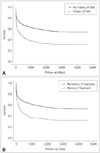
Fig. 2
A: Kaplan-Meier curve showing the probability of survival across the whole follow-up period in women with a history of falls compared to those with no history of falls. B: Kaplan-Meier curve showing the probability of survival across the whole follow-up period in women with a history of fractures compared to those with no history of fractures.
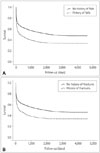
Table 1
Characteristics of men with stroke and a history of falls alone or of both falls and fractures compared with no history
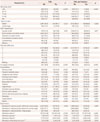
Normal C-reactive protein range=0–10 mg/L. Data are n (%) or mean±SD values.
*Missing data were removed from this analysis since there were no missing cases, †Independent t-test, ‡Natural logarithm of values used so as to produce a normal distribution, §p values for differences between patients with and without a history of falls (overall p for categorical data), ∥p values for differences between patients with and without a history of falls and fractures (overall p for categorical data).
mRS: modified Rankin Scale, OCSP: Oxfordshire Community Stroke Project.
Table 2
Characteristics of women with stroke and a history of falls alone or of both falls and fractures compared with no history
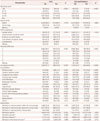
Normal C-reactive protein range=0–10 mg/L, Data are n (%) or mean±SD values.
*Independent t-test, †Natural logarithm of values used so as to produce a normal distribution, ‡p values for differences between patients with and without a history of falls (overall p for categorical data), §p values for differences between patients with and without a history of falls and fractures (overall p for categorical data).
mRS: modified Rankin Scale, OCSP: Oxfordshire Community Stroke Project.
Table 3
Effects of a history of falls on mortality after stroke in men and women
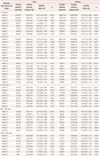
Model A: unadjusted. Model B: Model A+age, stroke type (ischemic or hemorrhagic), and OCSP classification (lacunar stroke, partial anterior circulation stroke, posterior circulation stroke, and total anterior circulation stroke). Model C: Model B+prestroke comorbidities (previous strokes, transient ischemic attacks, congestive heart failure, coronary heart disease, atrial fibrillation, myocardial infarction, diabetes, hypertension, peripheral vascular disease, chronic kidney disease, chronic obstructive pulmonary disease, dementia, hyperlipidemia, and cancer). Model C2: Model C–patients with a history of stroke. Model D: Model C+prestroke disability mRS score=0–5. Model E: Model D+acute illness parameters of admission white blood cell count and C-reactive protein. Model F: Model E+acute illness parameters of admission sodium, albumin, and glucose. Model G: Model F–prestroke disability mRS score.
*Analysis up to and including 30 days, †Analysis from 31 days onward.
CI: confidence interval, HR: hazard ratio, mRS: modified Rankin Scale, OCSP: Oxfordshire Community Stroke Project, OR: odds ratio.
Table 4
Effects of a history of falls and fractures on mortality after stroke in men and women
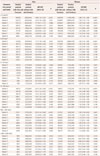




 PDF
PDF ePub
ePub Citation
Citation Print
Print


 XML Download
XML Download